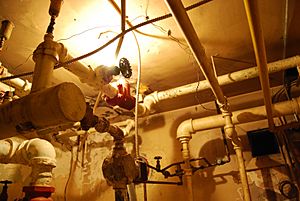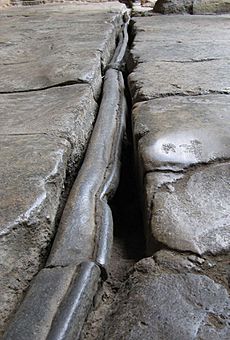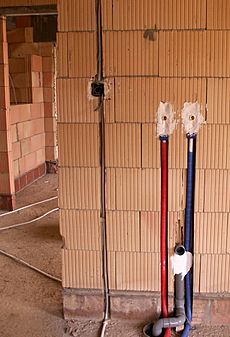Plumbing facts for kids
Plumbing is all about systems that move water and get rid of waste. The word 'plumbing' comes from the Latin word plumbum, meaning 'lead'. This is because pipes used to be made from lead.

A plumber is a skilled person who installs or repairs these water systems. They work with pipes, tubes, and things like water heaters. Plumbing is super important for any modern city. It helps make sure everyone has clean water and a safe way to get rid of dirty water.
Plumbing also means the actual system of pipes inside a building. It brings fresh water in and takes wastewater out. This is different from big city water systems that serve many buildings. Plumbing focuses on just one building.
Contents
The History of Plumbing
For a long time, plumbing was not common. People often just dumped waste onto the ground or into rivers. This changed in the 19th century when cities grew and people realized they needed better ways to handle waste for public health.
However, some ancient civilizations had plumbing systems thousands of years ago! The Indus Valley Civilization had pipes by 2700 B.C. Ancient Greeks, Romans, Persians, Indians, and Chinese also built public baths and needed ways to get drinking water and drain waste. The Romans even used special marks on pipes to stop people from stealing water.
These early systems did not improve much for a very long time. There were almost no big changes from the Roman aqueducts and lead pipes until the 1800s. Eventually, cities started building separate, underground systems for water and sewage. This helped get rid of open sewage ditches and cesspools.
Today, most large cities send solid waste through pipes to sewage treatment plants. These plants clean the water before it goes back into rivers or other water bodies. After World War II, most places stopped using lead pipes for drinking water. This was because of the dangers of lead poisoning. Instead, copper piping became popular because it was much safer.
Materials Used in Plumbing

In ancient times, water systems used gravity to move water. Their pipes were often made of clay, lead, bamboo, or stone.
Today, water supply systems use powerful pumps to move water. The pipes are made of materials like copper, brass, plastic, or other safe materials. Drain and vent pipes are made of plastic, steel, or cast-iron. Lead is no longer used for pipes because it can be poisonous.
The straight parts of plumbing systems are called pipes or tubes. Pipes are usually thicker and made by casting or welding. Tubes are thinner and made by extrusion. Tubes need special ways to join them, like 'brazing' or 'compression fitting'.
Besides straight pipes, many other parts are needed in plumbing systems. These include valves, elbows (for turns), tees (for branches), and unions (for connecting pipes).
Plumbing fixtures are the parts that people use directly. Some examples are toilets, urinals, bidets, showers, bathtubs, kitchen sinks, and drinking fountains.
Rules for Plumbing Work
In many places, plumbing work must follow strict government rules. These rules are called plumbing and building codes. They help make sure that plumbing is installed and fixed safely. This protects the people who live or work in the buildings.
Images for kids
-
Copper piping system in a building
-
Old water pipe, remnant of the Machine de Marly near Versailles, France
See also
 In Spanish: Fontanería para niños
In Spanish: Fontanería para niños
















